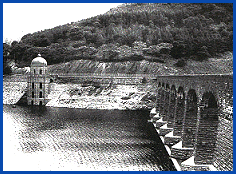
The Elan Valley dams
The Foel Tower
The location of
the Elan Valley dams
and reservoirs
is shown on the
sketch map.
The Foel Tower (right) is the starting point of the 73 mile journey of the water
 from the Elan Valley
to Birmingham. It was built in a style which, like many of the
other structures of the waterworks scheme, has become known as
'Birmingham Baroque'.
from the Elan Valley
to Birmingham. It was built in a style which, like many of the
other structures of the waterworks scheme, has become known as
'Birmingham Baroque'.This elegant stone tower houses a system of valves and cylinders which can be raised and lowered hydraulically to draw water off from the reservoir at various depths as required. This water is then directed into the start of the aqueduct, controlled by valves.
showing
water inlets
which are
normally
submerged
 The openings
at various levels in the base of the Foel Tower are visible in
this photograph, taken at a time of unusually low water in Careg-Ddu
reservoir.
The openings
at various levels in the base of the Foel Tower are visible in
this photograph, taken at a time of unusually low water in Careg-Ddu
reservoir.The top of the normally submerged dam below the Careg-Ddu viaduct is also showing above the waterline.
The water supply through the aqueduct is first fed to the filter beds just above the modern Elan Village. These beds were not part of the original planned scheme, but were decided upon in 1901 to reduce the risk of the clogging of the pipes in the aqueduct by peat, bracken and bacteria, based upon the experiences of Liverpool's scheme. The filtration is done by passing the water through beds of shingle and sand. The filters are backwashed every 48 hours, and the filtration process removes 150 tons of sludge every year.
Water levels in the upstream (Foel Tower) side of the submerged dam at Careg-Ddu are supplemented by water from the Claerwen river valley by means of a tunnel which starts just above the unfinished dam of Dol-y-Mynach. Although this dam was never continued to its planned height of over 100 feet, it still serves a useful function today by directing water retained by the huge Claerwen dam of 1952 into the system via the Dol-y-Mynach feeder tunnel.